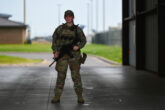May 27, 2014
Smith: 3 Questions for NATO on Pres. Obama's Plan for Afghanistan
The President’s announcement today that the United States will maintain 9800 troops in Afghanistan throughout 2015 has ended months of speculation about the U.S. post-2014 troop presence there. The lengthy debate has frustrated an array of U.S. defense planners, policymakers, members of Congress and think tank analysts eager for a decision that would define the U.S. relationship with Afghanistan going forward. But that debate has also had an impact on our NATO allies, many of which have been hesitant to make their own commitments before knowing exactly how the United States would proceed. With the final U.S. number now established, NATO allies are expected to provide a modest presence of an additional 3,000 to 5,000 troops. But the U.S. decision today raises three questions for NATO moving forward.
1. What will NATO’s presence in Afghanistan look like once the United States moves towards the second phase of the drawdown, now labeled the “Kabul and Bagram” presence, when it will cut the 9,800 troops by half, consolidating them in those two locations? With Germany committed to taking the lead in the North and Italy in the West, will those two nations continue to assume a leadership role even as the United States consolidates its forces in two primary locations? If not, who will be on hand to assist the hundreds, if not thousands, of civilians from foreign capitals and international organizations that will likely stay in Afghanistan for years to come?
2. How will NATO commit itself to Afghanistan’s future at its summit this September in Wales? After the Alliance pays tribute to the indispensible role it has played in Afghanistan over the last decade, NATO allies will need to determine their role in Afghanistan moving forward. Other than Germany and Italy, which NATO allies will contribute to NATO’s future mission to train, advise and assist the Afghan security forces moving forward? And at what level are NATO allies willing to continue to fund the Afghan National Security Forces (ANSF), especially if troop commitments prove to be a bridge too far?
3. Finally, if U.S. plans to withdraw the remaining troops by 2016 proves too ambitious, how might this affect NATO and NATO’s views on its Afghanistan mission in the long term? When the United States asked NATO to assist with the 2010 surge virtually all allies found ways to contribute despite low public approval ratings for the mission. But if the United States finds itself rethinking its commitment to withdraw its troops by 2016, can it rely on NATO allies to maintain their commitments a little longer?
More from CNAS
-
National Security Human Capital Program
Key Elements of the 2026 National Defense Authorization ActThis article was originally published on War on the Rocks. Although contemplating the personnel requirements of a large-scale conflict — and with it, the potential for casualt...
By Katherine L. Kuzminski
-
National Security Human Capital Program
Short SupplyExecutive Summary The U.S. military faces a critical challenge: Fewer young Americans are willing to serve, and fewer adults are encouraging them to do so. Because of delibera...
By Katherine L. Kuzminski & Taren Sylvester
-
National Security Human Capital Program
Defending the Army’s Command Assessment ProgramThe concept for CAP — developed during the first Trump administration — benefited from the guidance, input and oversight from the foremost scholar and practitioner on military...
By Katherine L. Kuzminski
-
National Security Human Capital Program
‘Women Don’t Just Achieve…They Excel’: Fmr. Marine Corps Attack PilotDr. Kyleanne Hunter, former Marine Corps attack pilot and CEO of Iraq & Afghanistan Veterans of America, says “women are the fastest growing group of veterans” and “the fastes...
By Dr. Kyleanne Hunter




